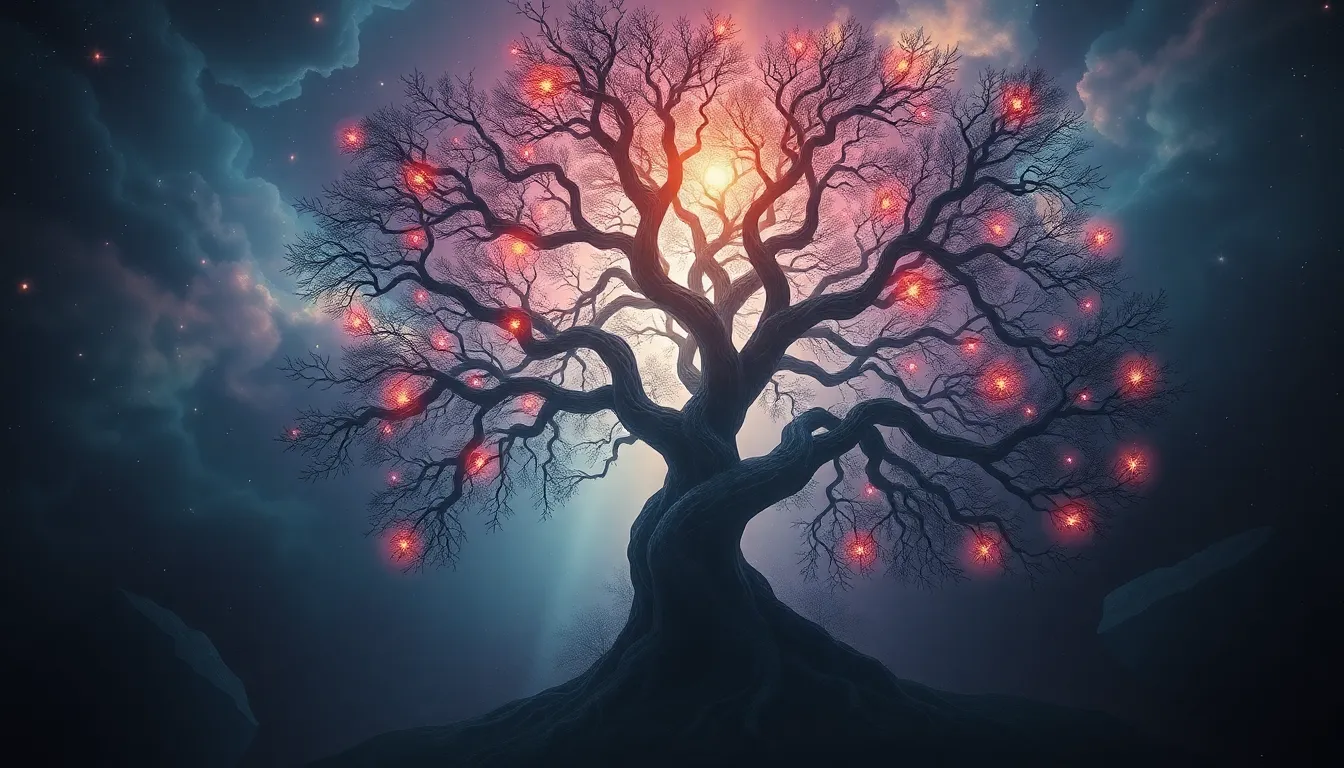The Tree of Dreams: Myths of Prophecy and Vision
I. Introduction
The concept of the Tree of Dreams is a powerful metaphor that encapsulates the intertwining of dreams, prophecies, and the wisdom of the subconscious. This motif appears across various cultures, symbolizing growth, knowledge, and the potential of the human spirit. Dreams have been regarded as significant sources of insight, guidance, and inspiration throughout history. They serve as a bridge between the conscious and the unconscious, often revealing hidden truths and messages.
This article aims to explore the historical context of dream interpretation, the symbolism of trees in mythology, the intersection of dreams and prophecy, notable myths featuring the Tree of Dreams, and modern perspectives on dreams. Through this exploration, we will uncover the enduring significance of dreams in contemporary society.
II. Historical Context of Dream Interpretation
A. Ancient civilizations and their views on dreams
In ancient civilizations, dreams were often viewed as divine messages. They were seen as omens or guidance from the gods. Different cultures had their unique interpretations of dreams:
- Mesopotamian beliefs: The Mesopotamians believed dreams were messages from the gods, often requiring interpretation by priests or dream interpreters.
- Egyptian dream texts: The Egyptians compiled dream interpretation texts, such as the “Dream Book of Artemidorus,” which categorized dreams and provided insights into their meanings.
B. The role of dreams in Greek and Roman mythology
In Greek and Roman mythology, dreams held a significant role. The Greeks believed in the god Morpheus, who was the deity of dreams and could take any form to appear in dreams. The Romans also recognized the power of dreams, often consulting oracles and seers to interpret their meanings.
C. Evolution of dream interpretation through the ages
As societies evolved, so did the methods of dream interpretation. From ancient scholars to modern psychologists, the understanding of dreams has transformed, incorporating both mystical and scientific perspectives.
III. The Symbolism of Trees in Mythology
A. Trees as symbols of life, growth, and wisdom
Trees have long been regarded as symbols of life, wisdom, and growth. They represent the interconnectedness of all life forms and the journey of personal development.
B. The significance of the Tree of Life and its variations
The Tree of Life appears in various mythologies, symbolizing the cycle of life, death, and rebirth. It serves as a reminder of the importance of nurturing one’s inner self and recognizing the potential for growth.
C. Trees in different cultural mythologies
Across cultures, trees are often featured in myths:
- The Norse Yggdrasil, an immense tree connecting the nine worlds.
- The Hindu Ashvattha tree, symbolizing eternal life and spiritual knowledge.
IV. The Intersection of Dreams and Prophecy
A. Dreams as prophetic visions in ancient texts
Throughout history, dreams have been considered prophetic, often foretelling future events. Many ancient texts recount dreams that influenced major decisions or foretold disasters.
B. Famous prophetic dreams in history
Some notable examples include:
- King Nebuchadnezzar’s dream interpreted by Daniel, which predicted the rise and fall of empires.
- Abraham Lincoln reportedly had a dream about his assassination days before it happened.
C. The psychological perspective on prophetic dreams
From a psychological standpoint, prophetic dreams may reflect the subconscious mind processing fears and hopes, often manifesting as symbolic warnings or insights.
V. Notable Myths Featuring the Tree of Dreams
A. Overview of specific myths from various cultures
Several myths prominently feature the Tree of Dreams, showcasing their cultural significance:
- The Norse Yggdrasil: A cosmic tree connecting the realms of existence, embodying the cycle of life and death.
- The Hindu Ashvattha tree: Represents the universe and the eternal nature of the soul.
B. Analysis of the lessons and morals in these myths
These myths often convey messages about the interconnectedness of life, the importance of dreams, and the wisdom that can be gleaned from both. They remind us to honor our dreams and the messages they carry.
C. Impact of these myths on contemporary beliefs about dreams
These ancient tales continue to influence modern interpretations of dreams, encouraging individuals to explore their meanings and significance in everyday life.
VI. Dream Interpretation Across Cultures
A. Differences in approaches to dream interpretation
Dream interpretation varies widely across cultures:
- Indigenous perspectives: Many Indigenous cultures view dreams as a means of communication with ancestors or spirits, often using them for guidance and healing.
- Western psychological theories: In Western psychology, dreams are often analyzed for their connection to the subconscious, reflecting personal desires and fears.
B. Common themes and symbols found in dreams globally
Despite cultural differences, certain themes and symbols recur in dreams worldwide, such as flying, falling, and being chased. These shared experiences highlight the universal nature of dreams.
C. Role of the Tree of Dreams in cultural interpretations
The Tree of Dreams serves as a potent symbol within these interpretations, often representing the potential for growth and self-discovery through dreams.
VII. Modern Perspectives on Dreams and Prophecy
A. Scientific research on dreams and their meanings
Recent scientific studies have explored the neurological basis of dreams, revealing their role in memory consolidation and emotional processing. Researchers continue to investigate the significance of dreams in understanding human psychology.
B. The resurgence of interest in dream analysis and prophecy
In contemporary society, there is a renewed fascination with dream analysis, spirituality, and prophetic dreams, reflecting a growing interest in the deeper meanings of our subconscious experiences.
C. The role of technology in dream interpretation today
Advancements in technology have led to the development of apps and platforms for tracking and analyzing dreams, making dream interpretation more accessible and interactive.
VIII. Personal Reflections: The Tree of Dreams in Contemporary Society
A. How individuals connect with the symbolism of the Tree of Dreams
Many people today resonate with the symbolism of the Tree of Dreams, using it as a metaphor for personal growth and exploration.
B. The therapeutic use of dreams in self-discovery and healing
Dreams are increasingly recognized as tools for self-discovery and healing in therapeutic settings, helping individuals process emotions and navigate life challenges.
C. Personal anecdotes and testimonies regarding prophetic dreams
Numerous individuals share anecdotes of prophetic dreams that have guided their decisions or provided warnings, reinforcing the belief in the power of dreams.
IX. The Future of Dream Studies
A. Emerging trends in dream research
As interest in dreams continues to grow, researchers are exploring new methodologies and interdisciplinary approaches to understanding dreams.
B. Potential implications for psychology and spirituality
Understanding dreams may lead to breakthroughs in psychology, spirituality, and personal development, offering deeper insights into the human experience.
C. The continuing significance of dreams in modern life
Dreams will likely remain a vital aspect of human culture, serving as a source of inspiration, guidance, and understanding.
X. Conclusion
In conclusion, the exploration of the Tree of Dreams reveals a rich tapestry of cultural beliefs, historical contexts, and modern interpretations. Dreams continue to hold significance across various cultures, serving as a bridge between the conscious and unconscious realms. By understanding the symbolism of dreams and their prophetic nature, we can unlock profound insights into ourselves and our place in the world. The Tree of Dreams invites us to nurture our inner wisdom and embrace the lessons that our dreams offer.




